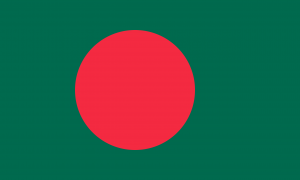Language/Bengali/Vocabulary/Colors
Hi Bengali learners! 😊
In this lesson, you will learn the vocabulary for colors in Bengali. Colors are an important aspect of any language as they are linked to culture and tradition. Learning the colors in Bengali will help you better understand the context of conversations and descriptions in Bengali. Knowing how to name colors will also enrich your vocabulary and allow you to create vivid and precise descriptions.
Colors in Bengali can be named in various ways, some of which are linked to emotions or cultural references. Before we dive into specific colors, let us understand how adjectives work in Bengali.
Take a moment to explore these relevant pages as you conclude this lesson:Geography, Seasons, Flowers & Greetings.
Adjectives in Bengali[edit | edit source]
In Bengali language, adjectives come after the noun they describe. This is the opposite of English, where adjectives generally come before the noun. This can sometimes lead to confusion for learners. Here is an example:
English: A red car Bengali: একটি লাল গাড়ি (Ekṭi lāl gāṛi)
Here, "red" is an adjective that comes before "car" in English. In Bengali, however, "lal" (red) comes after "car" in the sentence. Even though the structure is different, the meaning remains the same.
To describe a noun using multiple adjectives, Bengali uses a conjunction word "এবং" (ēbæng) which means "and". For example:
English: A big, yellow banana Bengali: একটা বড় হলুদ কলা (Ekṭa bôṛa hôlud kôla)
"হলুদ" (holud) means "yellow" and "বড়" (bôṛa) means "big".
Now, let's learn the vocabulary for colors in Bengali!
Basic Colors[edit | edit source]
Here are the basic colors that are commonly used in Bengali:
| Bengali | Pronunciation | English |
|---|---|---|
| লাল | lal | Red |
| সবুজ | shobuj | Green |
| নীল | nil | Blue |
| হলুদ | holud | Yellow |
| সাদা | shada | White |
| কালো | kalo | Black |
| গোলাপী | golapi | Pink |
| নারঙ্গী | narongi | Orange |
Here are a few tips to help you remember these colors:
- The word "lal" (red) is often used to express strong emotions such as anger or love. It also refers to the color of a bride's wedding dress. - The word "shobuj" (green) is linked to nature and symbolizes peace and prosperity. - The word "nil" (blue) refers not only to the color 'blue', but also to the sky and sea. It is a popular color for clothing. - The word "holud" (yellow) is linked to the sun and symbolizes happiness and hope. It is also the color of many traditional Bengali sweets such as "rosogolla". - The word "shada" (white) is linked to purity and cleanliness. It is commonly worn by Bengali men during formal occasions such as weddings and religious ceremonies. - The word "kalo" (black) is often linked to death, mourning and negative emotions. - The word "golapi" (pink) is associated with femininity and is a popular color for clothing. - The word "narongi" (orange) is often associated with autumn, harvest and is a symbol of excitement and enthusiasm.
Now, let's see these colors in a dialogue:
- Person 1: তোমার জামা কি হলুদ নাকি নীল? (Tomar jama ki holud naki nil?) (Is your dress yellow or blue?)
- Person 2: নীল। আমার পছন্দের দেবদূতের ওয়ান হলুদ। (Nil. Amar pochondo dar Devdooter own holud.) (Blue. My favorite bird, the 'Debdoot' is yellow.)
Other colors[edit | edit source]
In addition to these basic colors, Bengali also has a few other unique colors that are used to describe specific objects or concepts.
| Bengali | Pronunciation | English |
|---|---|---|
| বেগুনি | beguni | Eggplant color |
| বর্ণরাজ্য | barnorajjo | Rainbow |
| বাদামী | badami | Almond color |
| মরুভূমি | moru-bhumi | Desert color |
| অঙ্গুরি | onguri | Grapes color |
Here are some examples on how to use these colors in context:
- Person 1: তার ঘর বেগুনি রঙের। (Tar ghor beguni rong-er) (His house is eggplant colored)
- Person 2: গত বছর বর্ষাকালে আকাশে বর্ণরাজ্য দেখেছি। (Got bôchor bôrsha-kale akashae barnôrajo dekh-echi) (Last year in rainy season I saw a rainbow)
- Person 3: তোমার গায়ের চামড়া বাদামী হলে ভালো লাগবে। (Tomar ga-ye-r chom-do-ra badami ho-le bhalo laag-be) (Your leather shoes will look good in almond color)
- Person 4: হানিফ একটি সুন্দর নিউ ওয়ার্ল্ড ম্যাপ রেখে গেছে। সেটি মরুভূমি রঙের। (Hanif ekṭi sundor new world map rekhe geche. সেটি মরুভূমি রঙের।) (Hanif has hung a beautiful new world map. It is in desert color)
- Person 5: তোমার জুতা কি অঙ্গুরি রঙের? (Tomar juta ki onguri rong-er?) (Is your shoes in grape color?)
That's it! You now know how to name basic and unique colors in Bengali. Practice using these colors in your daily conversations to improve your vocabulary and communication skills.
To improve your Bengali Vocabulary, you can also use the Polyglot Club website. Find native speakers and ask them any questions!
➡ If you have any questions, please ask them in the comments section below.
➡ Feel free to edit this wiki page if you think it can be improved. 😎
Videos[edit | edit source]
Learn Bengali Colors Name in English For Beginners - YouTube[edit | edit source]
Bangla Color Names | Learn Colors in English and Bengali - YouTube[edit | edit source]
Other Lessons[edit | edit source]
Sources[edit | edit source]

